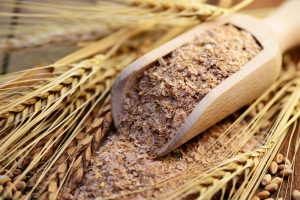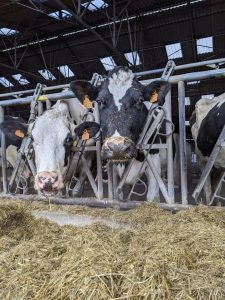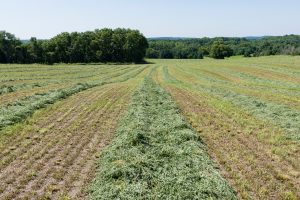Fernando Diaz
Glyphosate (N-phosphophonmethyl-glycine) is the most widely used herbicide, particularly in crops intended for animal feed. Given the controversy over its toxic effects, a German research group, led by K. Schnabel (2017 and 2020) conducted a feeding experiment to address these issues.
Since it is known that energy modulates the ruminal environment with possible consequences on glyphosate metabolism and effects on the animal, a first phase (2017) of the study focused on glyphosate’s effects in vivo on the productive performance and health of dairy cows fed rations with different concentrate feed proportions.
The objective of the second phase (2020) was to complete the above data by analyzing factors that could potentially be influenced by glyphosate such as hematological variables, immune cell phenotypes, oxidative status, and genotoxicity.
Experimental design
A total of 64 German Holstein cows were used in an experiment that lasted 17 weeks. After a week of adaptation in which all cows received the same feed, they were then separated in two groups: a GL group (GL) that received a ration including peas, wheat grain and wheat straw with glyphosate and a control group (CON) which received the same diet, but without glyphosate.
Both groups were in turn subdivided into one that received a diet with low concentrate inclusion (LC) composed on a dry matter (DM) basis of 21% corn silage, 42% grass silage, 7% straw and 30% concentrate, and another with a high concentrate level (HC) consisting of 11% corn silage, 22% grass silage, 7% straw and 60% concentrate.
Overall health
The first experiment recorded body condition score (BCS), weight, DM intake and milk production. Blood serum was analyzed for ß-hydroxybutyrate (BHB), non-esterified fatty acids (NEFA) and glucose, with the energy balance calculated. Milk was tested for glyphosate residues. It is worth noting that although the plants were grown on a plot that did not receive glyphosate for at least three years, the time of disintegration of the substance was not enough to have it completely disappear so that glyphosate residues were observed even in the control group. The average consumption of glyphosate in the groups CONLC and CONHC was 0.8 mg/d for both, whereas in the GLLC and GLHC groups was 73.8 and 84.5 mg/d, respectively.
The results indicated that BCS, body weight, net energy intake (NE) and NE balance were all affected by the proportion of concentrate in each ration, but glyphosate did not influence the parameters of either one. With regards to milk production, there were no changes in milk yield and composition in GL groups compared to CON groups.
The absence of glyphosate on dairy components could be related to the absence of its residues in milk, demonstrating that milk is not a major excretion pathway for this substance. Conversely, and not surprisingly, different energy concentration in the diet significantly influenced milk protein concentrations and yield, fat content, lactose, urea, somatic cell count and fat:protein ratio.
Overall, energy metabolism was not adversely affected by dietary treatments, since NEFA, BHB and blood glucose concentrations were all within normal reference values. The overall health of the cows was assessed by two veterinarians using a modified clinical score performed in five areas (cardiovascular, respiratory, gastrointestinal, locomotive, and udders). The clinical examination showed no adverse effect of glyphosate on cows’ health condition.
Hematological parameters
In the second experiment, blood serum was used for white and red blood cell counts. The following were recorded: subpopulations of T cells, oxidative burst capability of leukocytes, rate of apoptosis, phagocytic activity, superoxide dismutase and glutathione peroxidase activities, total non-enzymatic antioxidant capacity, viability and stimulation of peripheral blood mononuclear cells and micronucleus and comet test (to detect DNA damage).
The average daily consumption of glyphosate in the groups CON, GLLC and GLHC was 1.2, 112.6 and 132.8 μg/kg/day, respectively. The results showed that glyphosate residues in feed did not affect either the composition of the leukocyte population, including T-cell phenotypes, or the characteristics of cow erythrocytes. No significant influence of glyphosate on oxidative stress or neutrophil apoptosis was detected.
Unlike glyphosate, the concentrate levels of diets exerted marked effects on various parameters of red and white blood cell counts. The comet test did not reveal genotoxic effects and that of micronucleus also did not suggest any adverse effects of glyphosate.
Conclusions
- In the first experiment consumption of glyphosate (79.1 mg/d) did not affect the production and composition of milk or the metabolism and health of dairy cows.
- No glyphosate was detected in milk.
- In the second experiment an average daily exposure of cows to glyphosate of 122.7 g/kg did not induce adverse effects on the functional parameters of blood cells, redox status and genotoxic parameters.
- In both studies the proportion of concentrate and the time affected most parameters.
According to these results, the adverse effects of glyphosate on dairy cows can be dismissed with respect to the parameters considered in this study, and the conditions of this experiment.
References
- Schnabel, K., Schmitz, R., von Soosten, D., Frahm J., Kersten, S., Meyer, U., Breves, G., Hackenberg, R., Spitzke, M., Dänicke, S. 2017. Effects of glyphosate residues and different concentrate feed proportions on performance, energy metabolism and health characteristics in lactating dairy cows, Archives of Animal Nutrition, 71:6, 413-427.
- Schnabel, K., Schmitz, R., Frahm J., Meyer, U., Breves, G., Dänicke, S. 2020. Functionality and DNA-damage properties of blood cells in lactating cows exposed to glyphosate contaminated feed at different feed energy levels, Archives of Animal Nutrition, 74:2, 87-106.
© 2020 Dairy Knowledge Center. All Rights Reserved.









